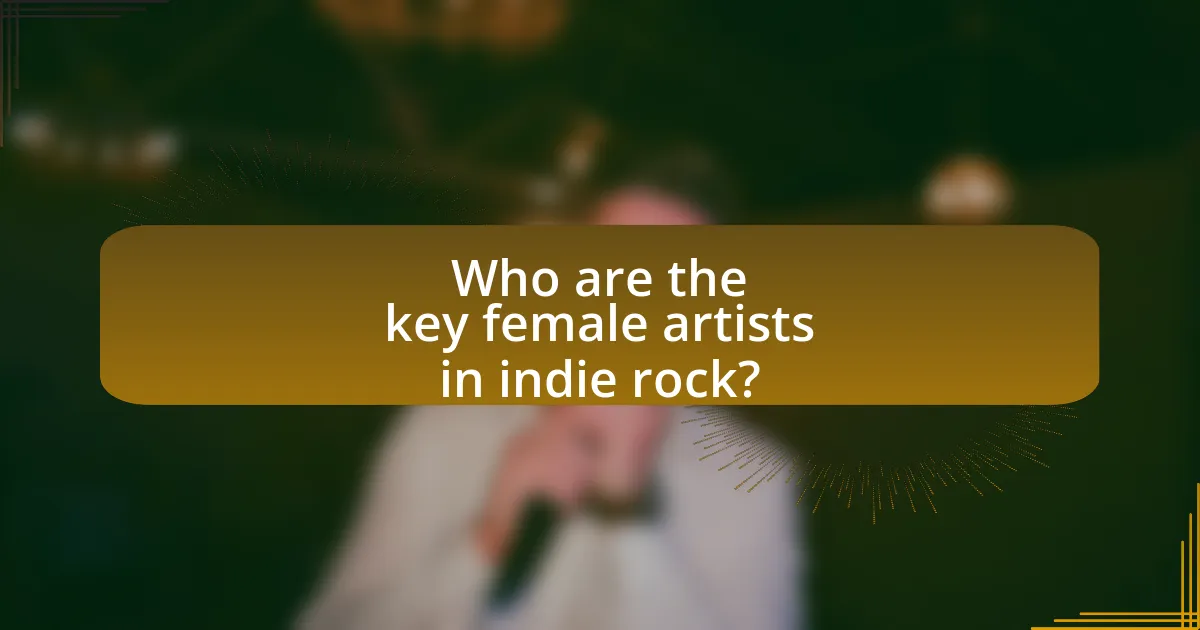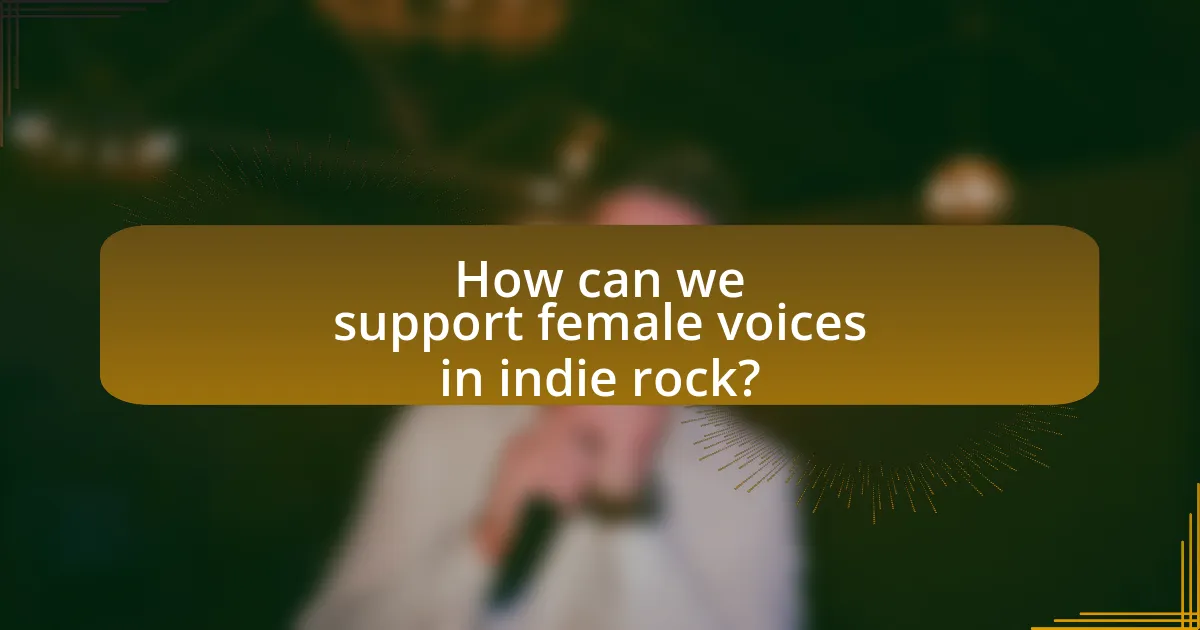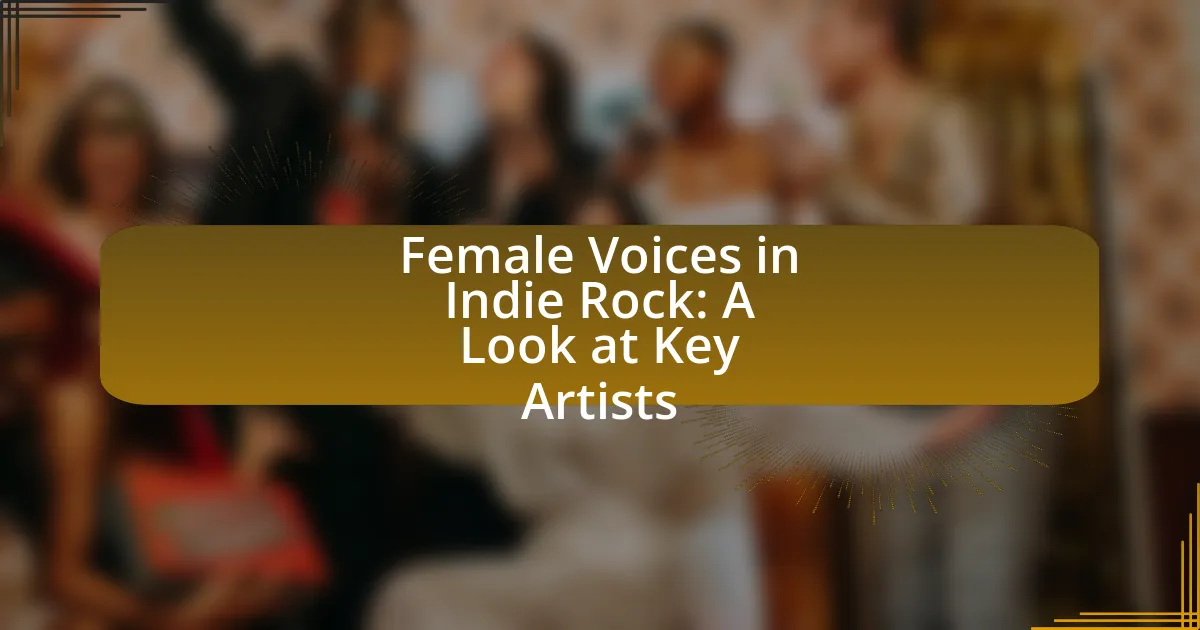Female voices in indie rock are characterized by distinct lyrical perspectives, emotional authenticity, and diverse vocal styles, setting them apart from mainstream rock. Key artists such as Fiona Apple, Liz Phair, and contemporary figures like Phoebe Bridgers and Mitski have significantly shaped the genre by exploring themes of identity, empowerment, and personal experiences. The article examines the impact of female representation in indie rock, highlighting the contributions of notable artists, the importance of diversity, and the evolving soundscapes within the genre. It also discusses how listeners can support female artists and engage with the growing community of women in indie rock.

What defines Female Voices in Indie Rock?
Female voices in indie rock are defined by their distinct lyrical perspectives, emotional authenticity, and diverse vocal styles. These artists often explore themes of identity, empowerment, and personal experiences, setting them apart from mainstream rock. For instance, artists like Fiona Apple and Liz Phair have been noted for their introspective lyrics and unique vocal delivery, which resonate with listeners on a personal level. Additionally, the rise of female-led bands such as Sleater-Kinney and CHVRCHES showcases a range of musical influences and innovative soundscapes, further enriching the genre. This combination of lyrical depth and vocal diversity contributes to the defining characteristics of female voices in indie rock.
How have female artists shaped the indie rock genre?
Female artists have significantly shaped the indie rock genre by introducing diverse perspectives, innovative sounds, and challenging traditional gender roles within the music industry. Artists like PJ Harvey and Liz Phair have influenced the genre through their unique songwriting and powerful performances, paving the way for future female musicians. Additionally, the rise of bands such as Sleater-Kinney and the impact of solo acts like Fiona Apple have contributed to a more inclusive and varied sound in indie rock, showcasing themes of empowerment and personal experience. The presence of female artists has not only expanded the genre’s sonic landscape but has also inspired a new generation of musicians to express their voices authentically.
What are the key characteristics of female voices in indie rock?
Female voices in indie rock are characterized by their emotional expressiveness, unique tonal qualities, and diverse vocal techniques. These voices often convey vulnerability and authenticity, which resonate with listeners, as seen in artists like Sharon Van Etten and Florence Welch. Additionally, female vocalists in this genre frequently employ a mix of soft and powerful dynamics, allowing for a wide emotional range. The use of unconventional melodies and harmonies further distinguishes their sound, contributing to the genre’s innovative nature. This combination of expressiveness, tonal uniqueness, and vocal diversity solidifies the distinctiveness of female voices in indie rock.
How do lyrical themes differ in songs by female indie rock artists?
Lyrical themes in songs by female indie rock artists often emphasize personal experiences, emotional vulnerability, and social commentary, distinguishing them from their male counterparts. Female artists frequently explore topics such as identity, relationships, mental health, and empowerment, reflecting a diverse range of perspectives. For instance, artists like Phoebe Bridgers and Mitski delve into introspective narratives that address loneliness and existential questions, while others like Florence Welch of Florence + The Machine incorporate themes of strength and resilience. This focus on personal and societal issues resonates with listeners, as evidenced by the critical acclaim and commercial success of albums that tackle these themes, such as Bridgers’ “Punisher” and Mitski’s “Be the Cowboy.”
Why is representation important in indie rock?
Representation is important in indie rock because it fosters diversity and inclusivity, allowing a broader range of voices and experiences to be heard. This genre has historically been dominated by male artists, which limits the perspectives and narratives available to audiences. By promoting female artists and other underrepresented groups, indie rock can challenge stereotypes, inspire new generations, and create a richer cultural landscape. For instance, the rise of female-led bands like Sleater-Kinney and artists like Phoebe Bridgers has not only expanded the genre’s appeal but also highlighted issues such as gender equality and personal identity, thus validating the importance of diverse representation in music.
What impact does female representation have on the music industry?
Female representation significantly enhances the music industry by promoting diversity, driving innovation, and expanding audience engagement. Research indicates that increased female presence in music leads to a broader range of perspectives and creativity, which can result in unique sounds and styles that resonate with diverse audiences. For instance, a study by the Annenberg Inclusion Initiative found that songs by female artists received more critical acclaim and commercial success when they were featured prominently in playlists, highlighting the market’s demand for varied voices. Furthermore, female representation challenges stereotypes and encourages young women to pursue careers in music, thereby fostering a more inclusive industry.
How does diversity in indie rock influence listeners and culture?
Diversity in indie rock significantly influences listeners and culture by broadening musical perspectives and fostering inclusivity. This genre showcases a variety of voices, particularly from women and underrepresented groups, which challenges traditional norms and promotes social awareness. For instance, artists like Mitski and Phoebe Bridgers have gained recognition for their unique narratives and emotional depth, resonating with diverse audiences and encouraging discussions around gender and identity. Research indicates that exposure to diverse musical styles and themes can enhance empathy and cultural understanding among listeners, as highlighted in studies by the Journal of Popular Music Studies. This cultural shift not only enriches the indie rock scene but also reflects and shapes societal values, making it a vital component of contemporary music culture.

Who are the key female artists in indie rock?
Key female artists in indie rock include Phoebe Bridgers, Mitski, and Sharon Van Etten. Phoebe Bridgers gained recognition for her emotionally resonant songwriting and collaborations, including her work with the supergroup Boygenius. Mitski is known for her unique blend of indie rock and pop, with critically acclaimed albums like “Be the Cowboy.” Sharon Van Etten has made significant contributions to the genre with her powerful vocals and introspective lyrics, particularly in her album “Remind Me Tomorrow.” These artists have shaped the indie rock landscape and are celebrated for their distinct voices and impactful music.
What contributions have notable female indie rock artists made?
Notable female indie rock artists have significantly contributed to the genre by shaping its sound, expanding its themes, and increasing representation. Artists like Liz Phair and Sleater-Kinney have pioneered a raw, confessional songwriting style that addresses personal and political issues, influencing countless musicians. Additionally, the rise of artists such as Phoebe Bridgers and Mitski has brought emotional depth and diverse perspectives to indie rock, showcasing experiences related to identity, mental health, and relationships. Their work has not only garnered critical acclaim but has also led to increased visibility for women in a historically male-dominated industry, as evidenced by the growing number of female-led bands and solo acts in indie music charts and festivals.
How did artists like Björk and Fiona Apple influence the genre?
Artists like Björk and Fiona Apple significantly influenced the indie rock genre by pushing the boundaries of musical experimentation and emotional expression. Björk’s innovative use of electronic elements and eclectic soundscapes in albums like “Homogenic” introduced a unique blend of genres, inspiring artists to explore non-traditional instrumentation and production techniques. Fiona Apple’s confessional songwriting style and complex arrangements in her album “Tidal” challenged conventional lyrical themes, encouraging a more introspective and personal approach in indie rock. Both artists have been pivotal in shaping the genre’s evolution, as evidenced by their critical acclaim and the way they have paved the way for subsequent female artists to express their individuality and creativity within indie rock.
What are the unique styles of contemporary female indie rock artists?
Contemporary female indie rock artists exhibit unique styles characterized by a blend of personal storytelling, diverse musical influences, and experimental sounds. Artists like Phoebe Bridgers and Mitski incorporate introspective lyrics and emotional depth, often drawing from personal experiences to create relatable narratives. Others, such as Snail Mail and Soccer Mommy, utilize a lo-fi aesthetic combined with melodic hooks, reflecting a raw and authentic approach to songwriting. Additionally, artists like Julien Baker and Lucy Dacus emphasize intricate guitar work and vocal harmonies, showcasing their musical versatility. This diversity in styles highlights the innovative contributions of female artists in the indie rock genre, pushing boundaries and redefining traditional soundscapes.
Which emerging female artists should we watch?
Emerging female artists to watch include Arlo Parks, who gained recognition for her debut album “Collapsed In Sunbeams,” which won the 2021 Brit Award for Best New Artist. Another notable artist is Phoebe Bridgers, whose unique sound and impactful lyrics have garnered critical acclaim, including Grammy nominations. Additionally, girl in red, known for her relatable themes and viral hits, has rapidly built a strong following in the indie scene. These artists exemplify the rising influence of female voices in indie rock, showcasing diverse styles and perspectives.
What trends are seen in the music of new female indie rock artists?
New female indie rock artists are increasingly characterized by a blend of introspective lyrics, diverse musical influences, and a strong emphasis on authenticity. This trend reflects a shift towards personal storytelling, where artists like Phoebe Bridgers and Snail Mail explore themes of mental health, relationships, and identity in their songwriting. Additionally, many of these artists incorporate elements from various genres, such as folk, pop, and electronic music, creating a unique sound that resonates with a broader audience. The rise of platforms like Bandcamp and social media has also empowered these musicians to reach listeners directly, fostering a sense of community and collaboration within the indie rock scene.
How are these artists redefining the genre today?
These artists are redefining the indie rock genre today by incorporating diverse musical influences and addressing contemporary social issues through their lyrics. For instance, artists like Phoebe Bridgers and Mitski blend elements of folk, pop, and electronic music, creating a sound that challenges traditional indie rock norms. Additionally, their lyrics often tackle themes such as mental health, identity, and feminism, resonating with a broader audience and pushing the genre towards greater inclusivity and relevance. This evolution is evident in the critical acclaim and commercial success these artists have achieved, as seen in Bridgers’ Grammy nominations and Mitski’s chart-topping albums, which highlight their impact on the genre’s landscape.

How can we support female voices in indie rock?
To support female voices in indie rock, we can actively promote their music through dedicated playlists, social media campaigns, and live events. Research indicates that female artists receive significantly less airplay and media coverage compared to their male counterparts; for instance, a 2020 study by the Annenberg Inclusion Initiative found that only 22.5% of artists on the Billboard Hot 100 were women. By creating platforms that highlight female musicians, we can increase their visibility and encourage more equitable representation in the industry. Additionally, providing mentorship opportunities and funding for female-led projects can further empower these artists and foster a more inclusive music scene.
What actions can fans take to promote female artists?
Fans can promote female artists by actively sharing their music on social media platforms, attending their concerts, and purchasing their merchandise. Social media engagement increases visibility; for instance, a study by Nielsen Music found that 70% of music discovery happens through social media. Attending concerts not only supports the artists financially but also helps build a community around their work, as live performances are crucial for indie artists. Additionally, buying merchandise directly supports female artists and helps them sustain their careers. These actions collectively enhance the reach and recognition of female artists in the indie rock scene.
How can social media be used to amplify female voices in indie rock?
Social media can amplify female voices in indie rock by providing platforms for visibility, engagement, and community building. These platforms allow female artists to share their music, connect with fans, and collaborate with other musicians, thereby increasing their reach and influence. For instance, artists like Phoebe Bridgers and Mitski have effectively utilized platforms like Instagram and Twitter to promote their work and engage with their audience, leading to increased recognition and support. Additionally, social media campaigns and hashtags, such as #WomenInMusic, have been instrumental in highlighting female talent and fostering discussions around gender equality in the music industry. This direct engagement not only enhances the visibility of female artists but also encourages a supportive community that champions their contributions to indie rock.
What role do music festivals play in supporting female indie rock artists?
Music festivals play a crucial role in supporting female indie rock artists by providing them with visibility, networking opportunities, and platforms to showcase their talent. These festivals often feature diverse lineups that include female artists, which helps to challenge gender stereotypes in the music industry. For instance, events like the All Points East Festival and the Newport Folk Festival have made concerted efforts to include a higher percentage of female performers, thereby promoting gender equality in music. Additionally, festivals often facilitate collaborations and mentorship opportunities, allowing emerging female artists to connect with established musicians, which can lead to career advancement. This support is essential in an industry where female representation has historically been limited, as evidenced by studies showing that women make up only about 20% of artists in popular music genres.
What resources are available for discovering female indie rock artists?
Online platforms such as Bandcamp, Spotify, and SoundCloud are valuable resources for discovering female indie rock artists. Bandcamp allows users to explore a wide range of independent music, often highlighting female artists through curated playlists and featured sections. Spotify offers playlists specifically focused on women in indie rock, such as “Women of Indie” and “Female Indie Rock,” which showcase emerging and established talent. SoundCloud provides a platform for artists to upload their music, making it easier to find new female indie rock musicians through tags and user-generated playlists. Additionally, music blogs like Stereogum and Pitchfork frequently cover female indie rock artists, providing reviews and recommendations that can guide listeners to new discoveries.
Which playlists or platforms focus on female voices in indie rock?
Playlists and platforms that focus on female voices in indie rock include Spotify’s “Women of Indie,” Apple Music’s “Women of Rock,” and YouTube’s “Female Indie Rock.” These playlists curate tracks from female artists and bands, highlighting their contributions to the indie rock genre. For instance, Spotify’s “Women of Indie” features a diverse range of artists, showcasing both established and emerging female talent, which reflects the growing recognition of women’s roles in the indie rock scene.
How can listeners engage with female indie rock communities?
Listeners can engage with female indie rock communities by attending live shows, participating in online forums, and supporting female artists on social media platforms. Attending concerts and festivals featuring female indie rock musicians fosters direct interaction and community building. Online forums and social media groups dedicated to female indie rock allow listeners to discuss music, share recommendations, and connect with like-minded fans. Supporting female artists through streaming platforms and purchasing merchandise contributes to their visibility and success, reinforcing the community’s growth. These actions collectively enhance listener engagement and promote a vibrant female indie rock scene.
What are the best practices for supporting female artists in the industry?
The best practices for supporting female artists in the industry include providing equitable access to resources, promoting visibility through platforms and events, and fostering mentorship opportunities. Equitable access ensures that female artists receive the same funding, studio time, and promotional support as their male counterparts, which is crucial given that women in music often face systemic barriers. Promoting visibility can be achieved by featuring female artists in festivals, playlists, and media coverage, as studies show that increased representation leads to greater recognition and success. Additionally, fostering mentorship opportunities connects emerging female artists with established ones, creating networks that can lead to career advancement and collaboration. These practices are supported by research indicating that diverse representation in the arts enhances creativity and innovation, benefiting the industry as a whole.
